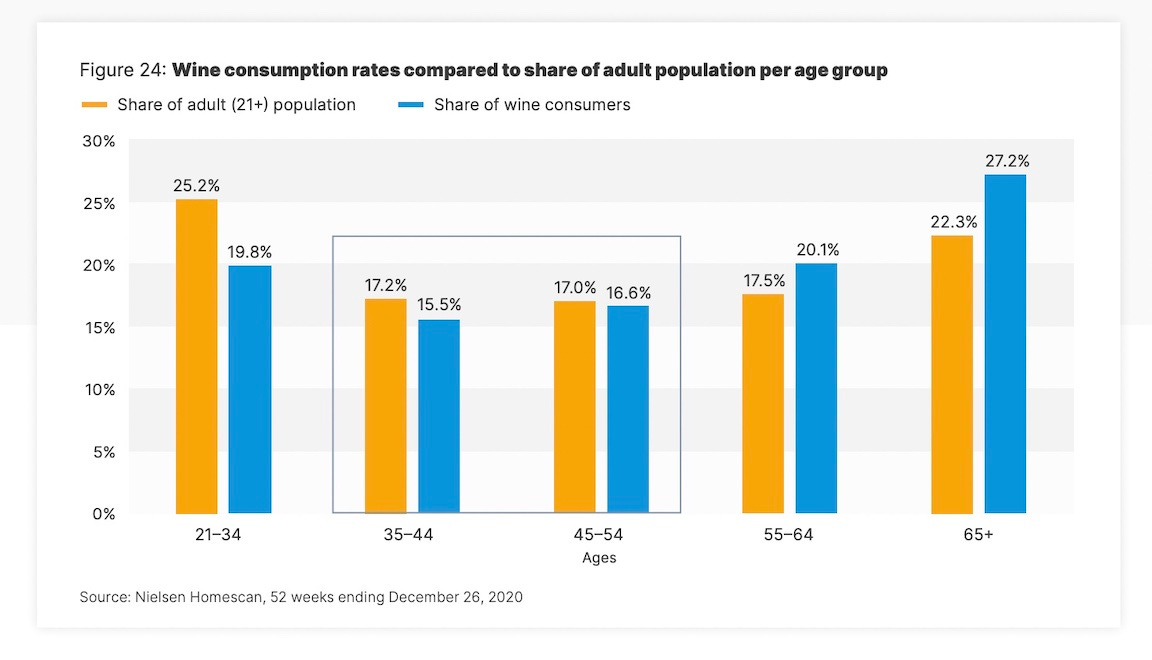Wine Marketing's Victimization of Old Folks
Courtney Cox and Clos Du Bois Show us the Ageism Visited Upon Old People
I’ve worked in wine marketing for more than 30 years and I have to admit I’ve never seen anything like this in that entire time: Clos Du Bois, the now Gallo-owned wine brand, is actively courting “older people” in their marketing campaigns. In this case, “Older” means over 50 years of age. Equally intriguing, they have enlisted actress Courtney Cox to spearhead the creative behind the campaign.
BUT WAIT….there’s more. From the press release announcing the Old People’s Campaign: “Clos du Bois is boldly embracing the stereotype that Chardonnay is old people's wine by proudly taking a stance against ageism in alcohol advertising.”
First of all, you have to notice that this is counter-programming. For the past few years, the single most important question that has swirled around the wine industry is how do we get younger people to drink more wine? Not, how do we get old people to drink more? If you believe the folks over at Gallup and their poll on alcohol consumption released last year, it turns out that among those 55 years or older, wine is the alcoholic beverage these fogies prefer most—and by a wide margin.
Equally interesting is the claim being made by Clos du Bois that ageism in alcohol advertising is the problem:
Historically, the alcohol advertising industry over-represents younger demographics. A recent survey conducted by Clos du Bois found that only 37% of people who are 55 and older agree that their age group is authentically represented within alcohol advertising. Through this campaign, Clos du Bois wants to change that statistic by highlighting a more authentic image of people over 50; reflecting the reality of consumers in this age group who are lively, adventurous and wise. The Long Live campaign features people over the age of 50 in front of and behind the camera – who all exude confidence and have the life experience that we all hope to attain.
It’s hard to know how Clos Du Bois came to the conclusion that younger people are overrepresented in alcohol advertising. The U.S. population 50 years of age or older is roughly 51%. I suppose they could have taken a look at a representative selection of TV, print, and digital alcohol advertising and eye-balled the people represented and taken a guess at their ages.
The fact that only 37% of those 55 years or older in a survey conducted by Clos Du Bois agreed they are “authentically” represented in alcohol advertising is also a fairly useless metric for judging the degree of ageism in alcohol advertising.
Let’s be clear about something the claim that alcohol advertising is ageist because older people are under-represented in alcohol advertising is no more a legitimate or useful claim than holding to the idea that the wine industry is racist because minorities are not represented in jobs in the exact degree of their percentage of the population. Much more is going on that can’t be determined by bean-counting.
And while I’m starting to sound like that old dude on his porch yelling at the kids to get off his lawn, where on God’s green earth does this come from:
“Many see Chardonnay as a wine primarily enjoyed by an older generation and there are associations that come with that. We are proving through our Long Live campaign how the perception of age stereotypes is changing as we celebrate our customers who enjoy Clos du Bois Chardonnay."
We like to talk about how things are viewed by folks but the question is what do people actually do. People of all age groups drink chardonnay. The chart below is from 2018, but I doubt much has changed. Not only is Chardonnay the most commonly purchased white wine in America, but there is very little difference in the amount of Chardonnay that is purchased by different age groups.
I would never suggest it’s a bad idea to target an older demographic in your wine marketing. In fact, isn’t it pretty smart? According to Nielsen, older Americans, particularly those above 50, are OVER-represented in terms of wine consumption.
This fact has been identified as a problem for the American wine industry. And I suppose it may be. But in terms of where a wine brand wants to look for buyers at this moment in time, it’s older Americans that seem to be paying greater dividends.
So, let’s be really clear about what’s going on here. Clos Du Bois and Courtney Cox are not righting a wrong. They are not drawing attention to the mythical ageism that infects alcohol advertising. They are not correcting the record where the image of Chardonnay is concerned. What Clos Du Bois’ marketing folks are doing is attempting to focus the attention of the largest contingent of wine drinkers on their brand, which it turns out is predominantly a Chardonnay brand.
I wonder if there would be a way to accomplish this without resorting to victim-based marketing?







